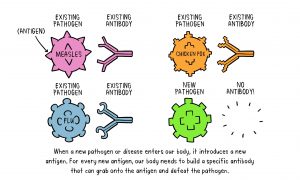Vaccine
The active ingredient of a vaccine is a harmless form of the bacteria or virus, which cannot cause disease. Vaccines contain a very small amount of an active ingredient, just a few micrograms, millionths of a gram per vaccine. The role of the active ingredient is to introduce antigens, which are unique features of the bacteria or virus, to your immune system. This induces a specific immune response in your body without making you sick. The immune system remembers the antigen so if you encounter the real bacteria or virus in the future, your body is ready to quickly respond before you become unwell. This is called immunity
The most abundant ingredient in a vaccine is water. The other ingredients in a vaccine are present in very small amounts and there is no evidence that they cause harm in these quantities with the rare exception of people with severe allergies to an ingredient. Vaccine ingredients may sound strange but many of them are naturally found in your body or in food, usually in much larger quantities than the amount used in a vaccine
Vaccines have a very small amount of a substance added to them to help create a stronger immune response to that vaccine. These substances are called adjuvants. Adjuvants are particularly useful for vaccines given to very young babies and older people, who have lower immune responses to vaccines. Aluminium salts, usually in the form of aluminium hydroxide, are used as an adjuvant in some other vaccines, for example the HPV vaccine, to strengthen and prolong the immune response the vaccine generates. Aluminium is naturally found in drinking water, breast milk and nearly all food
Very small amounts of preservatives and stabilisers are used in vaccines to maintain quality and ensure the vaccine is safe to be transported and stored. These ingredients are often naturally found in the body or in food at much higher levels than in a vaccine. Preservatives are added to vaccines to prevent unwanted contamination, much like they’re used in food products to stop them from spoiling. Stabilisers are also used in vaccines to stop the components separating or sticking to the vial during transportation and storage
www.immunology.org
www.who.int
